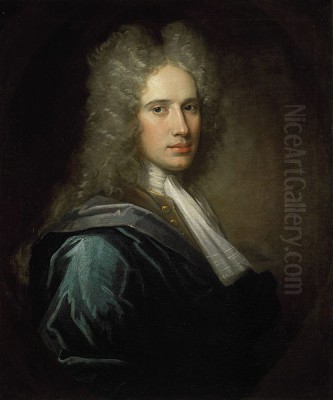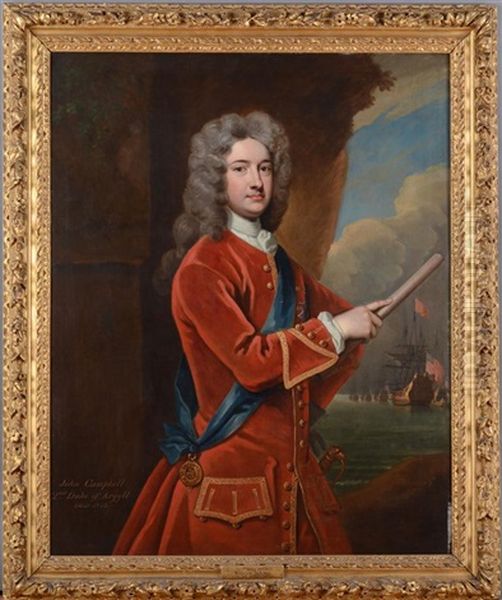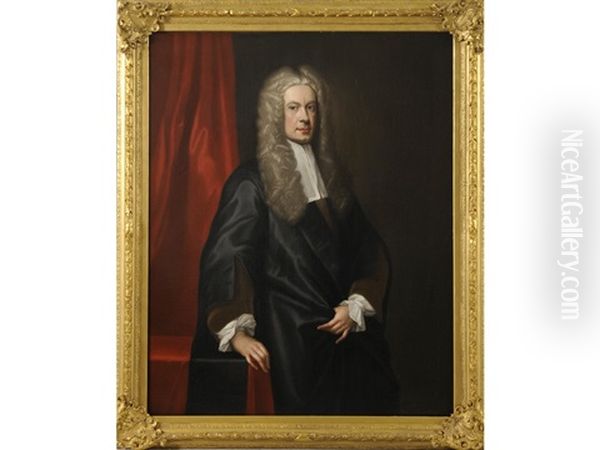
William Aikman stands as a significant figure in the history of Scottish art, particularly renowned for his portraiture during the late Baroque and early Georgian periods. Born on October 24, 1682, and passing away on June 7, 1731, his career bridged a crucial transition in British painting. He navigated the artistic worlds of Edinburgh and London, leaving behind a legacy of sensitive and accomplished portraits that captured the likenesses of many prominent figures of his time.
Early Life and Artistic Calling
William Aikman was born in Cairney, Forfarshire (now Angus), Scotland. His father, also named William Aikman, was a respected advocate and Sheriff of Forfarshire. The elder Aikman held ambitions for his son to follow him into the legal profession, a common path for young men of their social standing. However, the young William harboured a deep-seated passion not for law, but for the arts. Painting, poetry, and music captivated his interest far more than legal statutes and proceedings.
Despite his father's intentions, Aikman's artistic inclinations proved too strong to ignore. He resolved to pursue painting as his life's work. This decision marked a departure from the expected trajectory but set him on a course that would establish him as one of Scotland's foremost painters of his generation. To fund his artistic education and travels, Aikman eventually took the significant step of selling the family estate at Cairney, demonstrating his commitment to his chosen path.
Training and Formative Travels
Aikman's formal artistic training began under the tutelage of Sir John Medina (c. 1659–1710). Medina, a Flemish-Spanish painter who had settled in Scotland, was the leading portraitist in the country at the time. Studying with Medina provided Aikman with a solid foundation in the techniques and conventions of late Baroque portraiture, prevalent in Northern Europe. Medina's influence is visible in Aikman's early work, but the younger artist was keen to broaden his horizons.

Around 1707, Aikman embarked on an extensive period of travel and study abroad, a crucial step for ambitious artists of the era seeking to immerse themselves in the masterpieces of the past and the latest European trends. His journey took him first to Italy, the epicentre of the art world. He spent approximately three years based in Rome, diligently studying the works of the Old Masters and absorbing the artistic atmosphere of the city.
His travels did not end in Italy. Aikman ventured further east, visiting Constantinople (modern-day Istanbul) and Smyrna (modern-day Izmir) in the Ottoman Empire, as well as sites in Greece. These experiences were relatively unusual for British artists of the time and undoubtedly exposed him to different cultures and visual traditions, enriching his perspective beyond the standard Italian Grand Tour itinerary. He finally returned to Scotland in 1712, his skills honed and his artistic vision expanded.
Return to Scotland and Early Success
Upon returning to Edinburgh in 1712, William Aikman set up practice as a portrait painter. Sir John Medina had died in 1710, leaving a vacuum at the top of the Scottish art scene. Aikman, with his refined skills and continental experience, was well-positioned to fill this void. He quickly established a reputation for his elegant and lifelike portraits.
His talent attracted the attention and patronage of the Scottish nobility. Among his most important early patrons was John Campbell, the 2nd Duke of Argyll, a powerful and influential figure. The Duke's support was instrumental in launching Aikman's career and securing commissions from other members of the aristocracy and the gentry. For over a decade, Aikman remained the most sought-after portrait painter in Scotland, capturing the faces of the nation's elite.
During his time in Edinburgh, Aikman was not solely focused on painting. He cultivated his interests in literature and maintained friendships with key figures of the Scottish Enlightenment's early stirrings. His close friendship with the poet Allan Ramsay (1686–1758) was particularly significant, reflecting a shared cultural milieu where art and literature intertwined.
The London Years
By 1723, Aikman felt the pull of London, the larger artistic and social centre of Great Britain. Encouraged perhaps by his patron, the Duke of Argyll, who spent much time in the capital, Aikman decided to move south. This move coincided with the death of Sir Godfrey Kneller (1646–1723), who had dominated English portraiture for decades as Principal Painter to the King. Kneller's passing created an opportunity for other artists to rise to prominence.

In London, Aikman sought to establish himself amidst a competitive field of portraitists. His primary rival was the Swedish-born painter Michael Dahl (1659–1743), who, along with Kneller, had been a leading face-painter. Other contemporaries active in London included Jonathan Richardson the Elder (1667–1745), known for his portraits and influential art theory, and Charles Jervas (c. 1675–1739), who succeeded Kneller as Principal Painter. Enoch Seeman the Younger (c. 1694–1744) and the slightly younger Joseph Highmore (1692–1780) were also establishing their careers.
Aikman successfully carved out a niche for himself in London. His style, often perceived as more subtle and perhaps more psychologically penetrating than the grander, sometimes more formulaic approach of Kneller, found favour. He continued to paint portraits for the aristocracy and the cultural elite, bridging the gap between his Scottish connections and the London establishment. His studio became a meeting place for friends, including fellow Scots like the poet James Thomson (1700–1748), author of "The Seasons."
Artistic Style and Technique
William Aikman's artistic style is characterized by its refinement, naturalism, and a certain gentle quality. While trained in the Baroque tradition, his work often displays a softer touch and a greater emphasis on capturing the sitter's individual character than the more formalized state portraiture of Kneller. His approach can be seen as transitional, looking forward to the greater intimacy and psychological depth of later 18th-century portraiture.
His brushwork is typically fluid and assured, but less flamboyant than that of Rubens, to whom some earlier critics compared him perhaps more for his facility than direct stylistic similarity. Aikman favoured harmonious colour palettes and often employed soft, diffused lighting that modelled forms gently. He avoided the excessive drapery and elaborate allegorical settings sometimes found in the work of Kneller or French contemporaries, preferring simpler backgrounds that kept the focus firmly on the sitter.
Compared to his London rival Michael Dahl, Aikman's work might be seen as having a slightly cooler tonality and perhaps a more reserved sensibility, reflecting his Scottish roots and possibly his own temperament. His portraits convey a sense of quiet dignity and thoughtful presence. He excelled at capturing likenesses, a crucial skill for a portraitist reliant on patronage, but also imbued his subjects with a sense of inner life. This ability to combine accurate representation with subtle characterization was key to his success. The influence of his Italian studies can be detected in the competent drawing and compositional structure of his best works.
Notable Sitters and Representative Works
Throughout his career, Aikman painted many of the important figures of his day. His sitters included members of the aristocracy, politicians, military leaders, and prominent figures from the world of arts and letters. His connection to literary circles is evident in his portraits of poets. His depiction of John Gay (1685–1732), author of "The Beggar's Opera," is a well-known example. He also painted his close friends, the Scottish poets Allan Ramsay and James Thomson.
Among his portraits of political and intellectual figures are those of Duncan Forbes of Culloden (Lord President of the Court of Session), the philosopher and politician Fletcher of Saltoun, and the influential churchman William Carstares. These portraits serve as valuable historical documents, providing visual records of key players in early 18th-century Scotland and Britain.
One of Aikman's most highly regarded works is the portrait of General James Campbell, now housed in the Scottish National Gallery in Edinburgh. This painting exemplifies Aikman's mature style, showcasing his ability to convey both the sitter's status and personality with sensitivity and technical skill. The Gallery holds several other works by Aikman, forming the most important public collection of his paintings. Other works remain in private collections, including those of the Dukes of Argyll and Hamilton, descendants of his early patrons.
Aikman also painted a Self-Portrait for the collection of the Grand Duke of Tuscany in Florence, likely for the esteemed corridor of self-portraits in the Uffizi Gallery. This was a significant honour, placing him in the company of renowned European artists. For many years, this self-portrait was reportedly in the possession of his daughter, Mrs. Forbes, in Edinburgh.
Circle of Friends and Cultural Milieu
Aikman was known not only as a painter but also as a man of culture and amiable disposition. His interests extended beyond painting to encompass poetry and music. He moved comfortably in the literary and intellectual circles of both Edinburgh and London. His friendships with poets Allan Ramsay and James Thomson were particularly close and mutually supportive. Ramsay wrote verses lamenting Aikman's move to London and later elegized him upon his death. Thomson also penned lines in memory of his friend.
These connections highlight the vibrant cultural exchange occurring in Britain during the early Enlightenment. Aikman's studio, particularly in London, served as a gathering place for artists, writers, and patrons. While definitive evidence of close friendships with figures like Alexander Pope or Jonathan Swift is less certain, it is plausible they moved in overlapping social circles, particularly through shared patrons like the Duke of Argyll. Aikman's ability to connect with the leading creative minds of his time underscores his position within the cultural landscape.
His contemporaries in the arts were numerous. Besides the portraitists already mentioned (Kneller, Dahl, Richardson, Jervas, Seeman, Highmore), the artistic scene included figures like Sir James Thornhill (1675–1734), renowned for his large-scale decorative history paintings (e.g., at Greenwich Hospital and St Paul's Cathedral), and the emerging talent of William Hogarth (1697–1764), who was beginning to make his mark with conversation pieces and satirical prints. Marine painting was represented by artists like Peter Monamy (1681–1749). Although working in different genres, these artists formed the backdrop against which Aikman operated. Another portraitist active during Aikman's London period was John Vanderbank (1694–1739).
Later Life, Death, and Legacy
William Aikman's career in London continued successfully, but his life was marked by personal tragedy towards the end. His only son, John, died at a young age. Aikman himself suffered from declining health. Some accounts suggest he grew weary of the demands of his profession, perhaps the "business" aspect mentioned in anecdotes, though he remained active.
William Aikman died in London on June 7, 1731, not long after his son. According to his wishes, his body was transported back to Scotland. He was buried alongside his son in Greyfriars Kirkyard in Edinburgh, a site resonant with Scottish history. Several of his friends, including Allan Ramsay and James Thomson, wrote poems commemorating his life and talent.
Aikman's legacy lies in his contribution to Scottish portraiture and British art more broadly during the early 18th century. He was the first major native-born Scottish painter to achieve widespread recognition both at home and in London after the Act of Union in 1707. His style provided a bridge between the established Baroque manner of Medina and Kneller and the developing Rococo and Neoclassical sensibilities seen later in the work of painters like Allan Ramsay's son, also named Allan Ramsay (1713–1784), who became a leading portraitist of the next generation.
Aikman's work is valued for its technical competence, its elegant and naturalistic style, and its sensitive portrayal of character. He captured the likenesses of a generation navigating a period of significant political and cultural change. His paintings remain important records of the faces and personalities that shaped early Georgian Britain, particularly its Scottish dimension.
Conclusion
William Aikman navigated the worlds of law, art, Edinburgh society, and the competitive London scene with considerable success. Driven by a passion for painting, he overcame the expectation of a legal career, honed his skills through study with Sir John Medina and extensive travel, and established himself as the leading portraitist in Scotland before making a successful transition to London. His portraits, characterized by their subtle naturalism, harmonious execution, and insightful characterization, offered a distinct alternative to the grander style of Kneller. Friends with leading literary figures and patronized by the nobility, Aikman played a significant role in the cultural life of his time. Though his career was relatively short, ending with his death in 1731, William Aikman left an indelible mark on the history of Scottish art and remains a key figure in the development of British portraiture in the early 18th century. His works continue to be appreciated for their artistic merit and historical significance.